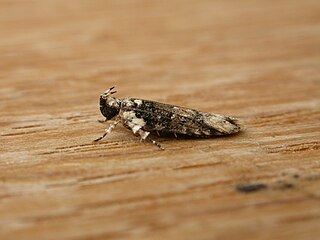Syngelechia is a genus of moths in the family Gelechiidae erected by Anthonie Johannes Theodorus Janse in 1958. Its only species, Syngelechia psimythota, was first described by Edward Meyrick in 1913. It is found in South Africa.

Microcolona limodes is a species of moth in the family Elachistidae. It is endemic to New Zealand. The larvae of this moth eat the seeds of endemic Myrsine species.

Microcolona characta is a moth in the family Elachistidae. It was described by Edward Meyrick in 1897. It is found in New Zealand and Australia, where it has been recorded from New South Wales.
Hypatima euplecta is a species of moth in the family Gelechiidae. It was described by Edward Meyrick in 1904. It is found in Australia, where it has been recorded from Queensland, New South Wales, Victoria and South Australia.
Hypatima loxosaris is a moth in the family Gelechiidae. It was described by Edward Meyrick in 1918. It is found in Mozambique and KwaZulu-Natal in South Africa.
Ardozyga chiradia is a species of moth in the family Gelechiidae. It was described by Edward Meyrick in 1904. It is found in Australia, where it has been recorded from Queensland.
Ardozyga aversella is a species of moth in the family Gelechiidae. It was described by Francis Walker in 1864. It is found in Australia, where it has been recorded from the states of Western Australia, Queensland, New South Wales, Victoria and South Australia.

Ardozyga sodalisella is a species of moth in the family Gelechiidae. It was described by Francis Walker in 1864. It is found in Australia, where it has been recorded from Queensland and New South Wales.
Ardozyga haemaspila is a species of moth in the family Gelechiidae. It was described by Oswald Bertram Lower in 1894. It is found in Australia, where it has been recorded from New South Wales and South Australia.
Gelechia epiphloea is a moth of the family Gelechiidae first described by Edward Meyrick in 1913. It is found in South Africa.
Scrobipalpa concreta is a moth in the family Gelechiidae. It was described by Edward Meyrick in 1914. It is found in South Africa and the former Orientale Province of the Democratic Republic of the Congo.
Metzneria heptacentra is a moth of the family Gelechiidae. It was described by Edward Meyrick in 1911. It is found in Zimbabwe and South Africa, where it has been recorded from the North-West Province, Gauteng, Mpumalanga, Limpopo and the Orange Free State.
Photodotis prochalina is a moth of the family Gelechiidae. It was described by Edward Meyrick in 1911. It is found in South Africa.
Cophomantella furnaria is a moth in the family Lecithoceridae. It was described by Edward Meyrick in 1913. It is known from South Africa.
Bida is a monotypic moth genus in the family Xyloryctidae described by Francis Walker in 1864. Its only species, Bida radiosella, described by the same author one year earlier, is found in Australia, where it has been recorded from New South Wales, South Australia, Tasmania, Victoria and Western Australia.
Catoryctis subnexella is a moth in the family Xyloryctidae. It was described by Francis Walker in 1864. It is found in Australia, where it has been recorded from the Australian Capital Territory, New South Wales, South Australia and Tasmania.
Cryptophasa balteata is a moth in the family Xyloryctidae. It was described by Francis Walker in 1866. It is found in Australia, where it has been recorded from New South Wales, Queensland and South Australia.
Lichenaula undulatella is a moth in the family Xyloryctidae. It was described by Francis Walker in 1864. It is found in Australia, where it has been recorded from New South Wales, Queensland and Western Australia.
Odites carcharopa is a moth in the family Depressariidae. It was described by Edward Meyrick in 1914. It is found on the Comoros in the Indian Ocean.
Agriophara atratella is a moth in the family Depressariidae. It was described by Francis Walker in 1866. It is found in Australia, where it has been recorded from Queensland and New South Wales.




